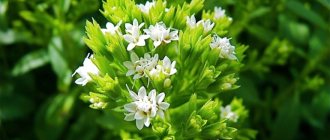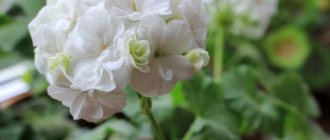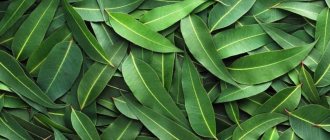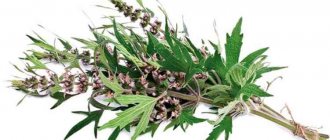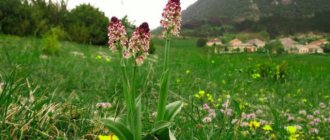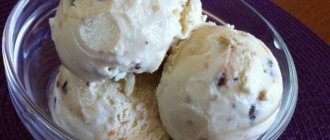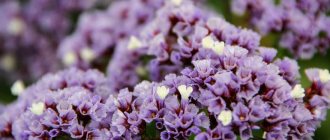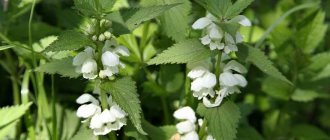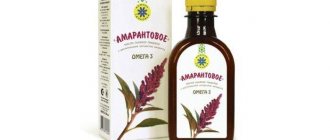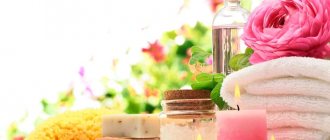Do you know what a shepherd's purse is? The medicinal properties and contraindications of this herb have been known for hundreds of years. Let's get to know her better. We will learn what a medicinal plant helps with, how to take it, and who it can harm.
I’ll also tell you how weed is used to prepare delicious dishes, and I’ll share an interesting recipe for a lotion that gets rid of acne and pimples.
Shepherd's purse flower: what does it look like, where does it grow?
The shepherd's purse is familiar to many from childhood. It grows up to 45 cm and is distinguished by its characteristic heart-shaped fruits. The name comes from Latin and translates as “shepherd’s bag.”
I can only guess what accessories Roman cowboys wore. But the name turned out to be sonorous and memorable.
English botanist William Coles wrote Adam in Eden (1657). He said this about weed:
It is called a shepherd's purse after the image of a seed that has the same shape. In it, shepherds carry food and drink to the field.
In our country, the shepherd's purse lives everywhere, except in the Arctic regions. It can be seen along roads, on vacant lots and embankments, in ravines, gardens, and vegetable gardens.
Flowering continues from spring to late autumn. The inflorescences are located at the top of the stem. The fruits are pods measuring 4-7 mm. Inside are small seeds about a millimeter in size.
The shepherd's purse is unpretentious. It produces a huge number of seeds - up to 50,000 per season. They remain viable for 5 years.
Natural reserves of the species are enormous and many times exceed the need for medicinal raw materials. I can’t even dare to call shepherd’s purse a weed, it’s so useful.
Common shepherd's purse
04/02/2019 Common shepherd's purse or shepherd's purse ( lat. Capsella bursa-pastoris
) is a herbaceous plant of the Brassica family and belongs to the class of dicotyledons.
This weed has many different names, among which the most popular are: babka, rezhukha, swan, shepherd, heart, grytsyk (Ukrainian version), spoons, bast grass, purse, seriki, totkun, arrows, chervishnik.
Shepherd's purse is polymorphic and modern botanists count more than 25 varieties of this plant.
In Ukraine, the shepherd's bagworm along with field bindweed ( lat. Convōlvulus arvēnsis
) and milkweed thistle (
lat. Sónchus arvénsis
) is one of the three most dangerous weeds of winter and spring wheat, since it heavily clogs the crops.
In addition to cereal plants, shepherd's purse can be found on row crops, vegetables, forage crops, and on crops of perennial grasses. The weed also grows on private plots, in vegetable gardens and orchards, but most often it can be found on uncultivated plots of land, wastelands, water meadows, along the sides of railway tracks, along highways and highways.
Shepherd's purse is a cosmopolitan plant. It easily adapts to life even in very difficult climatic zones, so it can be observed in various parts of the globe. For example, the weed can be found in heavily swampy areas or high in the mountains (the bagworm was found at an altitude of 2700 meters above sea level).
Maliciousness
Shepherd's purse has both spring and wintering varieties, but it is the winter form that causes the greatest problems for agriculture, since with the onset of autumn the weed begins to actively develop, thereby drowning out the crops of winter cereals. It also comes from the bagworm to vegetable and row crops.
Description of the plant
The stem of the shepherd's purse is simple, single and reaches from 20 to 50 centimeters in height. It is completely covered with small bristles, and the top of the weed is branched.
The lower leaves are in a basal rosette and sit on petioles. The stem leaves are lanceolate, elongated, pinnately divided and include serrated lobules. The upper leaves are arrow-shaped.
The root system of the shepherd's purse has a spindle-shaped shape.
The inflorescence is collected in a loose raceme. The flower petals are small, four-membered, regular in shape and colored white.
The fruit is a pod located on a long stalk. It has a flattened back triangular heart-shaped shape with a narrow partition in the middle.
Each nest contains up to 12 small seeds (their length reaches 1 mm, with a width of about 0.5 mm and a thickness of 0.25 mm). The grains have a rounded shape, slightly flattened on the sides and are colored dark burgundy. At the border of the embryo and cotyledon there are grooves.
Overwintered shepherd's purse seeds sprout in April-May, and spring seeds in June-July. Fruiting occurs in August-September.
The productivity of one plant is up to 70,000 seeds, and their germination level can be maintained for 11 years.
Reproduction of shepherd's purse occurs exclusively with the help of seeds (ripe pods burst and the grains fall to the ground).
The seeds demonstrate high vitality, retain the ability to survive the winter safely and germinate with the onset of spring.
During the growing season, one plant can produce two to three generations.
Weed control methods
One of the most effective agrotechnical methods for protecting winter crops is their thorough weeding and harrowing (the operation should be carried out just before the plants go into winter).
Shepherd's purse is highly sensitive to both soil-based and post-emergence herbicides, so their use is quite effective.
Protective measures also include peeling the area (to a depth of 6 to 8 centimeters) and autumn fall plowing.
With the onset of spring, it is advisable to carry out cultivation, which will destroy the rosettes of overwintered weed.
To clear row crops of this weed, inter-row tillage is usually used.
Use of the plant in pharmacology and cooking
Shepherd's purse is actively used in both folk and traditional medicine. Of particular value is the unique property of the plant to increase the tone of the uterus, restore the menstrual cycle and enhance muscle motility.
The unique hemostatic effect of the plant is well known, as well as its anti-inflammatory, vasodilating, blood purifying and wound healing properties.
Shepherd's purse contains a huge number of vitamins (including groups A, C, B2 and K), alkaloids, and a large number of macro and microelements.
The entire above-ground part of the plant, including leaves, stems, flowers and fruits, is used as medicinal raw material.
Decoctions and infusions from shepherd's purse help with cystitis, urolithiasis, and also as a means to improve the functioning of the heart muscle.
Drinks from shepherd's purse have a beneficial effect on the nervous system and cleanse the body of toxins.
In the East, valuable greenish vegetable oil is extracted from this plant. Its bitter taste is used as a condiment, and often replaces mustard.
What family does the shepherd's purse belong to?
The shepherd's purse plant belongs to the Cruciferous or Brassicaceae family. Among the local names the following are known:
— arrows,
— heart weed,
— field buckwheat,
— sparrow porridge,
— Cherevets.
The family includes more than 4 thousand species. These include radishes, turnips, arugula, broccoli, and kohlrabi. A distinctive feature is the abundance of species that bloom in the second year of life. The shepherd's purse is not one of them. This is an annual flower.
Representatives of this family are not recommended for hypothyroidism. They are classified as goitrogenic (goitrogenic) products. Most doctors believe that they promote enlargement of the thyroid gland. Vegetables interfere with the absorption of iodine, which is necessary for the synthesis of hormones.
Main contraindications
The bagman also has a number of contraindications. That is why, before treatment, it is necessary to find out for whom the use of medicines made on its basis is highly recommended. It is best to seek advice from your doctor.
You can't use a handbag:
- during pregnancy (with the exception of drugs that are prescribed by a doctor and taken under his supervision);
- in the presence of hemorrhoids or hemorrhoidal nodules;
- people with increased blood clotting;
- with thrombosis or thrombophlebitis.
Another factor in which it is extremely undesirable to use medicines prepared from bagworm is individual intolerance to the plant. You should carefully study all the risk factors that can be caused by self-administration of medicinal tinctures.
In addition, tinctures from bagwort are taken during heavy menstruation and lactation. It also has a therapeutic effect on endometriosis and uterine fibroids.
What does a shepherd's purse look like, photo
The appearance of weed is well known to many residents of the post-Soviet space, most countries of Europe and Asia. Let me remind you of the main characteristics by which you can recognize this valuable plant and not confuse it with others:
- height about 40 cm;
- length of lower leaves up to 9 cm;
- the stem is thin, erect, sometimes branched;
- the flowers are small, white, collected in an apical raceme;
- the pods are located in the middle part of the stem;
- spindle-shaped root.
Chemical composition
The healing power of the shepherd's purse is determined by its rich composition. It contains the following vitamins:
- ascorbic acid,
- phylloquinone (K),
- thiamine (B1),
- choline (B4),
- riboflavin (B2),
- inositol (B8),
- acetylcholine,
- carotene.
The above-ground part contains proteins, carbohydrates, saponins, and tannins. Leaves and inflorescences are rich in potassium. The seeds consist of 1/5 oil, which is suitable for technical purposes.
The composition contains essential oils, carotenoids, flavonoids, organic acids:
- sorrel,
- wine,
- bursa,
- lemon,
- apple
Another substance isolated from the terrestrial part is fumaric acid. Today it is known as dietary supplement E297. The compound actively participates in the metabolic processes of the body. Doctors use it to treat multiple sclerosis and skin diseases - eczema, psoriasis.
Some sources indicate the presence of tyramine. I have doubts about this data.
Tyramine is not thiamine (B1), although it sounds similar. The substance is a leader among migraine triggers. It is formed during the breakdown of tyrosine - an amino acid that is contained in protein products - cheeses (especially blue cheeses), meat, nuts.
Composition and medicinal properties of the herb
In folk medicine, the herb shepherd's purse is actively used due to the components that are included in its composition. Among them are:
- saponins;
- flavonoids;
- carbohydrates;
- vitamins;
- choline;
- taimin;
- organic acids;
- carotenoids;
- tannins.
The benefits of vitamin B1 in this plant help the human nervous system to function normally. Medicines containing it not only eliminate symptoms, but also help relieve the source of the disease. Herbalists and scientists have studied the abilities of this healing herb quite well and have since actively used it to prepare various dosage forms. It is important during treatment to strictly follow the instructions, which indicate the dosage and number of doses.
The most common properties of the herb are:
- hemostatic;
- blood purifying;
- astringent;
- anti-inflammatory;
- diuretic;
- sedative;
- vasodilator.
This is not a complete list of the beneficial effects of the plant; in fact, it is much broader. Before taking products based on shepherd's purse, it is recommended to consult a herbalist, as an overdose is possible, which is fraught with negative consequences.
Shepherd's purse herb: medicinal properties and contraindications
The shepherd's purse was well known to ancient Roman doctors and doctors of ancient Greece. They used the seeds for treatment. Residents of medieval Europe valued weed for its ability to quickly stop bleeding.
Today the plant is actively used in homeopathy. It is well known to folk herbalists and healers, and is used by official medicine. Pharmacies sell convenient filter bags or packs of dried raw materials. Sometimes an alcoholic extract is found.
The leaves have phytoncidal activity. They secrete biologically active components that suppress the proliferation of harmful microorganisms.
Pharmaceutical preparations of shepherd's purse are prescribed for pulmonary, uterine, and gastrointestinal bleeding. Most often they are combined with other ingredients. For gynecological diseases, the herb is brewed together with viburnum, and for kidney problems - with horsetail.
Collection for hemorrhoids:
- chamomile flowers,
- peppermint,
- stinging nettle,
- sage,
- elecampane root
- shepherd's purse,
- yarrow,
- calendula.
The ingredients are taken in equal proportions. Mix them, measure out 1 tbsp. l., pour 1 tbsp. boiling water Leave for 1-1.5 hours, filter. Drink 1/3 tbsp. three times a day before meals. With long-term use, the composition reduces blood pressure.
Shepherd's purse is often included in various collections. It is brewed together with oak bark for tuberculosis.
What are the possible contraindications?
Shepherd's purse is not recommended for those with a tendency to hemorrhoids, increased blood clotting, acute inflammatory diseases of the kidneys and urinary tract. With long-term use, a decrease in blood pressure is possible.
Monitor closely for allergies. If there are signs of individual intolerance, use should be stopped immediately.
The pharmacy instructions contain a contraindication for pregnant and lactating women. How it fits in with pies and other dishes containing weed is an open question.
If you have chronic diseases, discuss use with your doctor. Sometimes taking it causes constipation or thickens the blood. In some cases, it causes a delay of menstruation by 1-2 days.
Folk recipes with shepherd's purse
Leaves fresh and dry
They are rich in nutrients and can be used as an additive to salads, borscht, soups, and as a filling for pies. Also, fresh leaves and celery are used to make a healthy vitamin paste: it can be spread on toast, bread, and eaten as a sandwich. Dry seeds can be used in cooking instead of mustard and pepper. Dry leaves are good to add to soups at the end of cooking.
Infusion
The main dosage form, which is universal and suitable for all diseases for which the plant helps:
- especially effective for pulmonary, uterine, kidney and intestinal bleeding, after abortion and childbirth, with heavy menstruation;
- also characterized by anti-inflammatory and wound-healing effects;
- recommended for gastritis, gastric and duodenal ulcers, intestinal atony, diarrhea, dysentery, liver pathologies;
- prescribed as a choleretic drug for cholelithiasis, cholecystitis, and vomiting;
- used as a diuretic for rheumatism, gout;
- helps in the treatment of oncopathology of the female genital area and stomach.
10 gr. dry raw materials, pour 0.2 liters of boiling water and leave for 30 minutes under the lid, filter through gauze. Take 1 tbsp. up to 4 r/day before meals, 20 minutes.
Externally, the infusion is indicated for washing wounds, including wounds, ulcers, for compresses, and rubbing for bruises.
Tea
2 tsp the herbs are mixed with 250 ml of boiling water, infused for 10 minutes and filtered. Take 2 cups of this tea per day. A drink prepared with melt water is especially useful for cleansing the blood after long-term treatment with strong drugs, and in the spring - as a general strengthening drug.
Liquid extract in 70% alcohol
It is sold in pharmacies, but you can get it yourself. Dry plant materials are infused with 70% alcohol in a ratio of 1:10 for 14 days in a dark, warm place, then filtered. Take 20 drops. 3 times a day for uterine bleeding and uterine atony.
Aqueous extract
Obtained when the alcohol form cannot be taken. Prepare an aqueous infusion according to the recipe described above, then steam it until 2/3 of the volume has evaporated, and cool. Take 1 tbsp. 3 r/day.
Vodka infusion
1 part of the dry plant is poured with 10 parts of vodka, left for 21 days and filtered. Take 20 drops, diluted in water. Helps relieve joint pain, normalizes stomach function and blood pressure in hypertension.
Juice
Grind the plant to a pulp and squeeze out the juice, which is diluted 1:1 with boiled water. Take 3 times a day, 40 drops (indications are similar to infusion). Previously, the juice was used as a natural contraceptive.
Drug for the treatment of endometriosis
One liter of dry white wine is poured into 100 grams of dry herbs, left for about 14 days and filtered. Take 1 tbsp. up to 6 times during the day and so on until the drug runs out. Afterwards they take a break of 1 month and repeat the course.
Medicine to strengthen the body of older people
Mix shepherd's purse flowers and hawthorn flowers, valerian (roots) and lemon balm leaves in a ratio of 10:10:5:5. 1 tsp The mixture must be poured with 200 ml of cool water and left for at least 10 hours. Take in small sips throughout the day, pre-heated.
Use with other medicinal plants
Most often, shepherd's purse is used in combination with other medicinal plants. So, for uterine bleeding, a liquid extract of shepherd's purse with viburnum extract or tincture of water pepper is indicated. For kidney bleeding, combine with horsetail.
Pharmacy fees
Included in the collections sold through the pharmacy chain, which are indicated for uterine bleeding, menorrhagia, cystitis, urolithiasis, pyelonephritis, for neutralizing and removing toxins after the use of oncological drugs.
Shepherd's purse: medicinal properties and use in folk medicine
The healing power is impressive, but the application has a number of peculiarities. The effectiveness of treatment and taste indicators depend on a number of factors:
- region and place of growth,
- weather conditions,
- processing quality,
- collection time,
- varieties.
Decoctions of shepherd's purse were taken for stomach ulcers, malaria, and typhoid fever. They are used for kidney stones, cholecystitis, dysentery, and rheumatism. It is a strong astringent and wound healing agent. The high content of flavonoids and potassium helps cope with heart disease.
In Chinese traditional medicine, shepherd's purse is widely used along with other wild herbs. It is believed to have a beneficial effect on the stomach and liver. It is used to treat hemorrhoids and diarrhea. It normalizes blood pressure and is useful for heart failure.
Shepherd's purse dilates blood vessels and has a mild diuretic effect. In addition, she demonstrates the following positive qualities:
- cleanses the blood of toxins;
- reduces inflammation;
- reduces temperature;
- calms;
- normalizes sleep;
- improves stomach function, heals erosions and ulcers;
- relieves swelling.
Infusions and decoctions prevent the spread of pathological flora in pneumonia and tuberculosis. External use accelerates wound healing, has an anti-inflammatory and antiseptic effect.
Preparation of a healing decoction:
- Place 2 tablespoons of dry herbs in an enamel pan.
- Pour a glass of boiling water and let simmer for 1-2 minutes.
- To cover with a lid.
- Wait 30-40 minutes.
- Strain.
Take 50 ml 3 times a day.
Preparation of the infusion:
- 2 tbsp. l. place the raw materials in a thermos.
- Pour a glass of boiling water.
- Close tightly.
- Leave for 3 hours.
Take a tablespoon 4 times a day. For joint pain, make compresses with infusion, which are left overnight.
During menstruation
Many women suffer from pain before and during the menstrual period. Often they are delayed, do not occur on time, which prolongs these painful processes. When menstruation is delayed, it is recommended to drink grass juice with honey.
You need to take this mixture 5 times a day, 1 tsp. after meal. To prepare juice, you need to take the above-ground part of the plant, which is still young. Finely chop and squeeze. If your period does not appear on time, you have a delay and at the same time you feel incredible pain, often pulling in the lower back and lower abdomen, then use an infusion of herbs.
Infusion recipe for delayed menstruation:
- 2 tbsp. l. pour 200 ml of boiling water over the bagworm;
- let it brew for 2 hours;
- strain without fail;
- take 4 times a day, 1 tbsp. l.
For some reason, periods can be very heavy, which causes a lot of discomfort and worry. This can happen due to previous illnesses or stress.
If this question arises, then you need to prepare a decoction:
- 5 g of shepherd's purse pour 200 ml of boiling water;
- put in a water bath for 10 minutes, strain the broth;
- take 35 drops 5 times a day before meals.
Shepherd's purse: medicinal properties in gynecology
Weed has become widely accepted in the treatment of diseases of the female genital area. It is included in many herbal preparations. Its use is often combined with red brush and hogweed.
The water infusion stops bleeding and increases the contractility of the muscular layer of the uterus. Until recently, women drank decoctions for heavy menstruation and postpartum bleeding.
Shepherd's purse is used for inflammation of the appendages and uterine atony - the main cause of postpartum hemorrhage. It is useful for the following deviations:
- menstrual irregularities,
- pain during menstruation,
- pronounced PMS,
- climacteric syndrome,
- endometriosis,
- andexit.
The plant helps cope with hot flashes during menopause, stops internal bleeding, and prevents the development of pathological processes. Some sources note a contraceptive effect.
For beauty
If you are prone to inflammation, acne and clogged pores, it is recommended to make compresses with a decoction of shepherd's purse. If you have oily skin, prepare a lotion for daily wipes. Mix 200 ml of decoction and calendula tincture from the pharmacy.
Pour into a glass bottle and keep in the refrigerator. Wipe problem areas daily. The course is two weeks, after which take a break.
In cooking
Young leaves are a rich source of nutrients. They appear in early spring, when a shortage of vitamins is felt. All over the world, greens are used to make soups, salads, and baking fillings.
In China, Korea and Japan, shepherd's purse is a food crop. It is especially popular in Shanghai and the surrounding area - Jiangnan. It is fried with rice and used as a filling for square dumplings - wontons.
Hindus and Japanese throw fresh leaves into the broth with meat. Dried leaves enhance the taste of fish dishes. And Koreans even eat roots. They are added to namul, a popular dish of greens and wild vegetables.
In France, tender greens are an essential ingredient in spicy salads, and New England colonists replaced pepper with them.
In the Caucasus, the young leaves of the shepherd's purse bloom after the wild garlic. They are used as an ingredient in salads, vinaigrettes, and vitamin soups. They replace spinach and chard. And ground seeds are a good alternative to mustard.
In Armenia and Nagorno-Karabakh they prepare jingyalov hats. The dish resembles cheburek, but is fried in a dry frying pan. The filling consists of finely chopped herbs - about 20 ingredients. Along with the young leaves of the shepherd's purse, it includes nettle, cilantro, dill, parsley, spinach, and dandelion. A correctly composed bouquet determines the taste.
What does a decoction of shepherd's purse treat?
In addition to oral administration, it can also be used for douching. Take:
- 2 tbsp. l. herbs;
- 1 glass of water.
Boil for a minute over low heat. Leave for half an hour and then pour through a piece of fabric. Perform the procedure with a warm decoction before bedtime for diseases of the uterus. Such procedures prevent the growth of the endometrium.
For prostatitis
The shepherd's purse is useful not only for women, but also for men. Take:
- 100 g of grass;
- 1 liter of boiling water.
Leave for 45 minutes. Drink ½ glass 3 times a day for 2-3 weeks.
INTERESTING fact: Polypore - medicinal properties and recipes
Simple ways to treat complex diseases:
Did you know that salt dressings work wonders? This recipe was published in Healthy Lifestyle in 2002. Unfortunately, it is not well forgotten, but deliberately erased from memory and discredited by pharmaceutical companies in pursuit of ... Read more
Honey and flax - strong health! Honey with flax seeds is the best remedy for blood vessels and immunity! Detoxify with flax seeds! Colon detoxification is possible using natural remedies. … Read more
MIRACLE MIXTURE FOR THE BODY I always determined the age plus or minus 1-2 years. Once I was visiting and there was a woman there, everyone thought that she was about 35 years old, but from the conversation we realized that we were mistaken. They asked how many… Read more
8 natural products that destroy parasites in the body Most of the world's population suffers from parasitic diseases. Common natural remedies will help your body fight parasites. Parasitic… Read more
Even 1 date causes an irreversible process in the body! Dates are an amazing fruit, which in many countries is credited with the properties of improving health and prolonging life. They say that in China there are long-livers, the basis... Read more
For hypertension
Ingredients:
- 2 tbsp. l. chopped stems and leaves;
- 250 ml water.
Pour the liquid over the herb and place it on the fire. Bring to a boil and then simmer for just a minute. Leave for half an hour. Drink 15-30 drops with high blood pressure, diluted with water.
